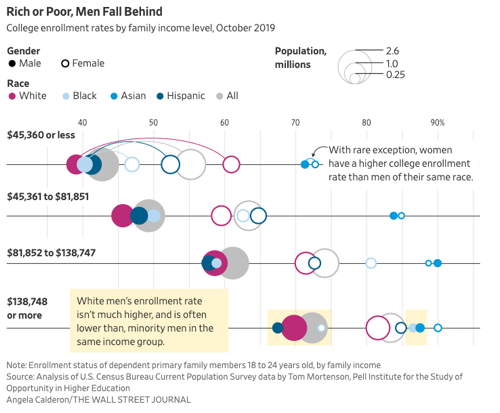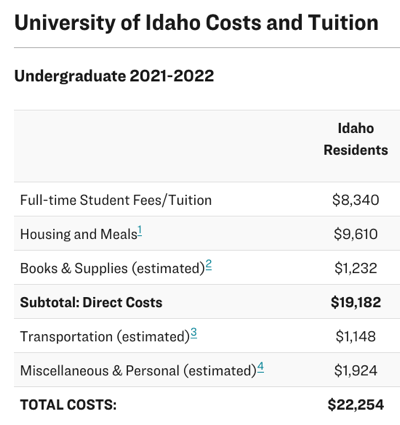 My Op-Ed on the failure of higher education to compete with Vo-Tech ran in today’s Moscow-Pullman Daily News.
My Op-Ed on the failure of higher education to compete with Vo-Tech ran in today’s Moscow-Pullman Daily News.
For decades, demographers have warned about declining birth rates and the impending education enrollment cliff. In the 2020-2021 academic year, U.S. colleges and universities had 1.5 million fewer students compared to five years ago, and that’s not strictly due to COVID. Furthermore, men in particular are abandoning higher education in droves, accounting for 71% of that five-year decline.
In 1980, the number of women enrolled in college was the same as the number of men. At the end of the 2020-2021 academic year, 60% of enrolled college students were women while 40% were men. After six years of undergraduate classes, 65% of the women received a bachelor’s degree compared with 59% of the men. Furthermore, men bailing on college cuts across all demographics: race, geography, economic, etc. In fact, white men’s enrollment rate is often lower than minority men in the same income group.
I asked one of Emsi’s data scientists to provide me with a demographic report of the total number of men and women awarded bachelor’s degrees from US public institutions in 2020 by program. The findings were unsurprising: men make up 75-85% of high-paying science, technology, engineering, and mathematics (STEM) degrees. Women generally choose easier degrees than men with less occupational and monetary reward, which doesn’t help with the overall cheapening of the college experience.

The university model is becoming obsolete where it used to count the most. Because women avoid STEM programs and men are bailing on college, companies who hire STEM majors are forced to look elsewhere for their labor force. Today, this is especially evident in the computer programming and information technology world.
For many years, you needed a computer science degree to be considered for a programming job. However, companies increasingly realized that a college diploma was no guarantee of competency, relevant skills, or motivation. So about 25 years ago, Microsoft implemented the practice of testing college graduates before hiring them.
Google, Apple, IBM, and Microsoft are among companies no longer requiring college degrees for new hires. Apple CEO Tim Cook said in 2019 that half of Apple’s new US hires consisted of people without four-year degrees.
Today, tech companies are bypassing colleges altogether. Google recently launched a “digital jobs program” under its Google Career Certificates program, which only takes about six months to complete and doesn’t require any previous experience. The courses are designed to prepare enrollees for in-demand jobs with average annual salaries of $63,600.
Access to these courses on Coursera costs $39 per month or $234 for those six months, although you can take them at your own pace. Certificate exam fees are only $149. Alternatively, a family could spend $10,000 for a 12-week, hands-on coding bootcamp and have the graduate come out with near-guaranteed job placement in the $50k salary range.
 Compare that to the fact that the average UI student graduates with a bachelor’s degree after six years at a total cost of $134,000. They have $30,000 in debt, are six years behind in their careers compared to those who went the credentialing route, and they have no guarantee that their college classes are relevant in the current job market. They will likely have to retool anyway.
Compare that to the fact that the average UI student graduates with a bachelor’s degree after six years at a total cost of $134,000. They have $30,000 in debt, are six years behind in their careers compared to those who went the credentialing route, and they have no guarantee that their college classes are relevant in the current job market. They will likely have to retool anyway.
This “down-credentialing” will continue to hurt colleges since they cannot compete with companies who are willing to take motivated high school graduates (or even dropouts), pour six months of Vo-Tech training into them, and provide them with a life-long vocation that pays well. An Emsi research study shows a 4% decline in job postings requiring a bachelor’s degree since early 2020 and expects this skills-based hiring trend to be long-term.
As mentioned, men mostly comprise STEM programs, and they are even bailing on those for more rational training. Colleges can’t retain their most profitable degree seekers because they can’t compete with the cost-value ratio of on-site training for STEM careers. I have little hope that this 40-year trend will turn around.
Much of this has to do with universities shifting away from their core competency of educating (teaching how to think) to Vo-Tech (training how to do). Because of significant academic and bureaucratic inertia in higher education, colleges will never be able to compete in the Vo-Tech arena with private institutions, nor should they try. Colleges are making themselves obsolete by focusing on training skills that can be so easily replaced with on-site training or even self-study.